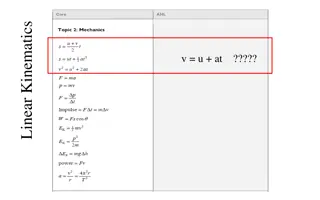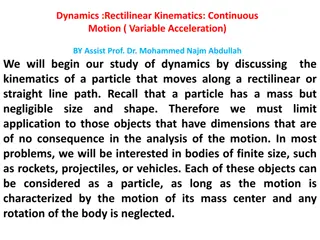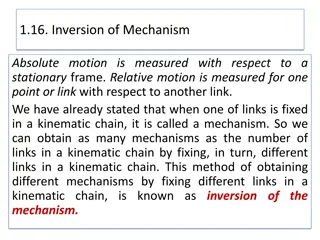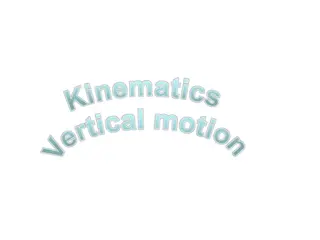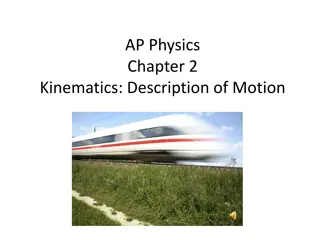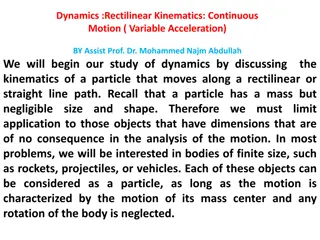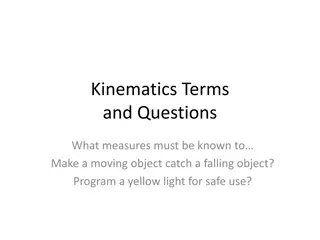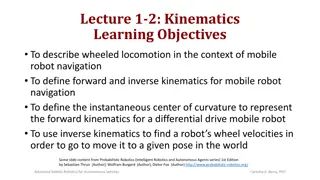
Dive into Kinematics Vocabulary - Understanding Units, Vectors, and Scalars
Explore the fundamentals of kinematics vocabulary including units, vectors, and scalars in physics. Learn about time, position, duration, displacement, distance, speed, velocity, and more. Enhance your understanding of key concepts in kinematics.
Download Presentation

Please find below an Image/Link to download the presentation.
The content on the website is provided AS IS for your information and personal use only. It may not be sold, licensed, or shared on other websites without obtaining consent from the author. If you encounter any issues during the download, it is possible that the publisher has removed the file from their server.
You are allowed to download the files provided on this website for personal or commercial use, subject to the condition that they are used lawfully. All files are the property of their respective owners.
The content on the website is provided AS IS for your information and personal use only. It may not be sold, licensed, or shared on other websites without obtaining consent from the author.
E N D
Presentation Transcript
Kinematics Vocabulary Units and vectors and scalars, oh my!
t: time s (second) {alt. min, hour, year} scalar No formula (fundamental measurement) When? One clock reading
x: position m (meter) {alt: inch, foot, mile } vector No formula Where? Location relative to origin or ZERO position
t: duration s (second) {alt. min, hour, year} scalar t = tf- ti How long? Change of time, elapsed time, period of time
x: displacement m (meter) {alt. foot, mile, etc} vector x = xf- xi How far and which way from start position? Change of position
d: distance m (meter) {alt. foot, mile, etc} scalar d = total length of path How far? Total size of path traveled
Savg: Average Speed m/s (meters per second) {alt. mile/hour} scalar Savg= d / t How fast? Average rate of distance traveled
vavgAverage Velocity m/s (meters per second) {alt. mile/hour} vector vavg= x / t vavg= slope of (secant) line on x vs t graph How fast and which way (has the object been moving)? Average rate of change of position
v: (Instantaneous) Velocity m/s (meters per second) {alt. mile/hour} vector v= slope of (tangent) line on x-t graph How fast and which way (is/was the object moving at a certain time)? Rate of change of position at a given time NOTE: When velocity is constant, the velocity at every instant is the same as the average velocity for the interval
S: (Instantaneous) Speed m/s (meters per second) {alt. mile/hour} scalar S= |v| How fast? Rate of distance traveled at a certain time NOTE: When velocity is constant, the speed at every instant is the same as the average speed for the interval
m/s/s OR m/s2(meters per second squared) {alt. feet per second squared} vector ? = v / t How quickly and which way the velocity changes? Average rate of change of velocity
a: (Average ) Acceleration m/s/s OR m/s2(meters per second squared) {alt. feet per second squared} vector aavg= v / t How quickly and which way the velocity changes? Average rate of change of velocity NOTE: We will limit our study of motion to situations where the acceleration is CONSTANT
Relationships Acceleration is to velocity as _____________ is to ________________ Zero velocity means constant _____________ Constant velocity means zero _____________
Kinematics Terms and Graphs Examine, or determine the values of the coordinates of one point on the graph Calculate the slope, or determine any trends with the slope Type of Graph You will know the position of an object at a given time; knowing this for two points on a graph enables you to compute slope. You will know the velocity, or know if the velocity is constant, increasing or decreasing position vs time You will know the velocity of an object at a given time; knowing this for two points on a graph enables you to compute slope. You will know the acceleration, or know if the acceleration is constant, or not velocity vs time


